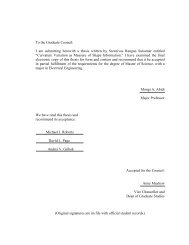To the Graduate Council: I am submitting herewith a dissertation ...
To the Graduate Council: I am submitting herewith a dissertation ...
To the Graduate Council: I am submitting herewith a dissertation ...
- No tags were found...
Create successful ePaper yourself
Turn your PDF publications into a flip-book with our unique Google optimized e-Paper software.
Chapter 2: Related Work 10In <strong>the</strong> literature, a common distinction is found between fine and coarse registrationmethods [C<strong>am</strong>pbell01], which are often used in a two-stage fashion. Coarse orpreliminary registration can be obtained by several techniques, including hardwaresolutions, such as rotating tables, which were used to scan small objects. But morecommonly, a set of matches is used for <strong>the</strong> alignment of <strong>the</strong> views. Thesecorrespondence points can be obtained interactively as in most commercial 3Dmodeling packages [RapidForm02]. Fully automatic 3D matching using exhaustiveconstrained search techniques were attempted [Chen99]. However, <strong>the</strong>se methods arecomputationally expensive and sensitive to noise. Invariant features are morefrequently employed to reduce <strong>the</strong> search space, playing an important role in systemsthat aim for <strong>the</strong> automation of <strong>the</strong> reconstruction process. <strong>To</strong> achieve fine registration,by far <strong>the</strong> most widely used algorithm is <strong>the</strong> Iterative Closest Point (ICP) algorithmand its very numerous variants and extensions. This accurate method is commonlyused as a refinement step after an initial coarse registration was obtained.2.1.1 Registration with invariant featuresGiven a set of corresponding points between two 3D data sets, Horn [Horn87] deriveda closed from solution to <strong>the</strong> absolute orientation problem. Similar results were alsoobtained in [Faugeras86]. Automatically establishing <strong>the</strong> set of correspondences to beused in such algorithm is a common interest to both registration and object recognitiontasks. Several feature descriptors were used to represent free-form surfaces and pointsets. In <strong>the</strong> class of global descriptors spherical representations such as <strong>the</strong> SphericalAttribute Image (SAI), which mapped surface curvature values into a tessellatedsphere, were employed for 3D registration [Higuchi95][Hebert95]. Also to thiscategory belongs <strong>the</strong> work of Lucchese et al [Lucchese02] extending frequencydomainmethods to range data registration. Park and Subbarao [Park04] employed <strong>the</strong>invariant Stable Tangent Plan (STP) for crude registration.
















